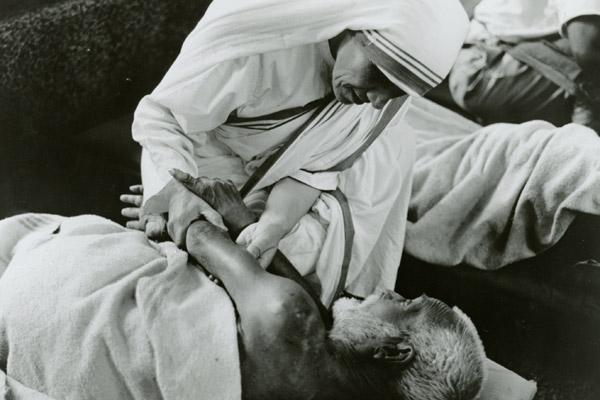
VATICAN CITY — When Pope Francis canonizes Blessed Teresa of Kolkata Sept. 4, he won’t simply be fulfilling a special duty of his office, he will be honoring a woman he has called “a symbol, an icon for our age.”
When talking about the intersection of prayer, mercy, concrete acts of charity and peacemaking, Mother Teresa was Pope Francis’ go-to reference.
In one of his early morning homilies in November, Pope Francis spoke about war and about how, by the way they live their lives, many people promote hatred rather than peace and selling weapons rather than sowing love.
“While weapons traffickers do their work, there are poor peacemakers who give their lives to help one person, then another and another and another,” the pope said. Mother Teresa was clearly one of the peacemakers, he added.
“With cynicism, the powerful might say, ‘But what did that woman accomplish? She spent her life helping people die,’” Pope Francis said, noting that the cynics do not realize that Mother Teresa understood the path to peace and they do not.
A much longer papal reflection on lessons from the life of Mother Teresa was published in July; Pope Francis wrote the preface to an Italian publisher’s book of talks Mother Teresa gave in Milan in 1973.
Mother Teresa’s life showed the centrality of prayer, charity, mercy in action, family and youth, Pope Francis wrote.
“Mother Teresa untiringly invites us to draw from the source of love: Jesus crucified and risen, present in the sacrament of the Eucharist,” the pope wrote. She began each day with Mass and ended each day with eucharistic adoration, which made it possible “to transform her work into prayer.”
Her prayer led her to the extreme edges of society — the peripheries — recognizing the poor and the marginalized as her brothers and sisters and offering them compassion, he said.
The little nun in the blue-trimmed white sari teaches people that “feeling compassion is possible only when my heart embraces the needs and wounds of the other,” witnessing to God’s caress, the pope wrote.
The Gospel tells people they will be judged at the end of time for how they fed the hungry, clothed the naked and cared for others in need, he said. “Mother Teresa made this page of the Gospel the guide for her life and the path to her holiness — and it can be for us, as well.”
Pope Francis also noted in the book that, from her experience ministering to the rejected, Mother Teresa knew and constantly emphasized the importance of family and family prayer. Home, he said, is the place people learn “to smile, to forgive, to welcome, to sacrifice for one another, to give without demanding anything in return, to pray and suffer together, to rejoice and help each other.”
Please read our Comments Policy before posting.
Article comments powered by Disqus Pope asks Christ to 'roll away' the stones of war
Pope asks Christ to 'roll away' the stones of war
 'Why, Lord?' appropriate prayer in grief, Pope says
'Why, Lord?' appropriate prayer in grief, Pope says
 Pope: For Lent, put appearances aside and listen to God
Pope: For Lent, put appearances aside and listen to God
 Spiritual oasis: Year of Prayer is stop before jubilee
Spiritual oasis: Year of Prayer is stop before jubilee
 Pope tells TV show host he's not thinking of resigning
Pope tells TV show host he's not thinking of resigning
 Winning directory photo honors Our Lady of Guadalupe
Winning directory photo honors Our Lady of Guadalupe
 St. Paul says: How does the Bible define love?
St. Paul says: How does the Bible define love?
 6 steps to getting married in Diocese of Little Rock
6 steps to getting married in Diocese of Little Rock
 Most frequently asked questions on Catholic marriage
Most frequently asked questions on Catholic marriage
 St. Joseph a model of solidarity with immigrants
St. Joseph a model of solidarity with immigrants
 Two gifts after Jesus’ death: Virgin Mary and Eucharist
Two gifts after Jesus’ death: Virgin Mary and Eucharist
 Why we have an altar, and not just a communion table
Why we have an altar, and not just a communion table
 Pope: Wars should be resolved through nonviolence
Pope: Wars should be resolved through nonviolence
 Living relationship with Jesus Christ in the Eucharist
Living relationship with Jesus Christ in the Eucharist